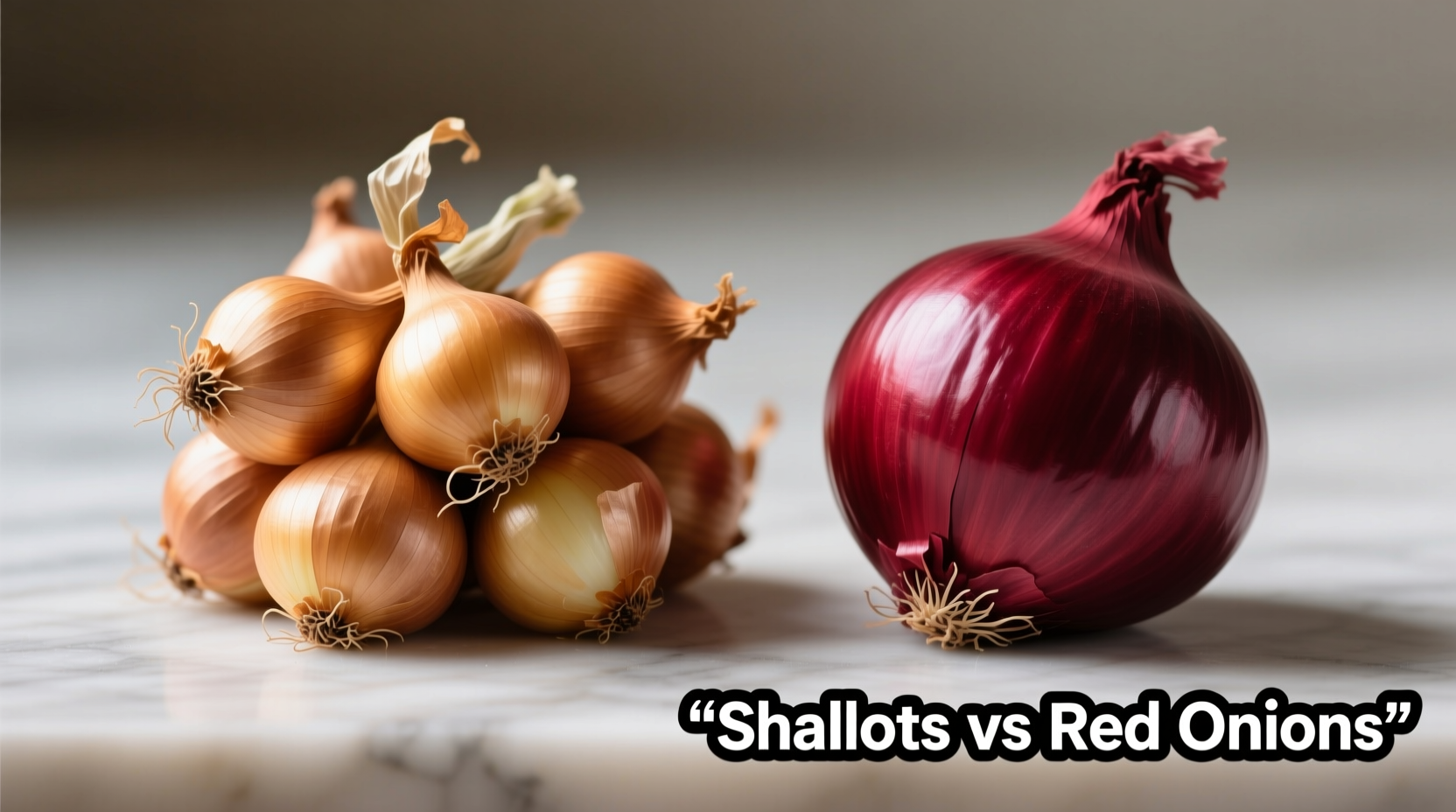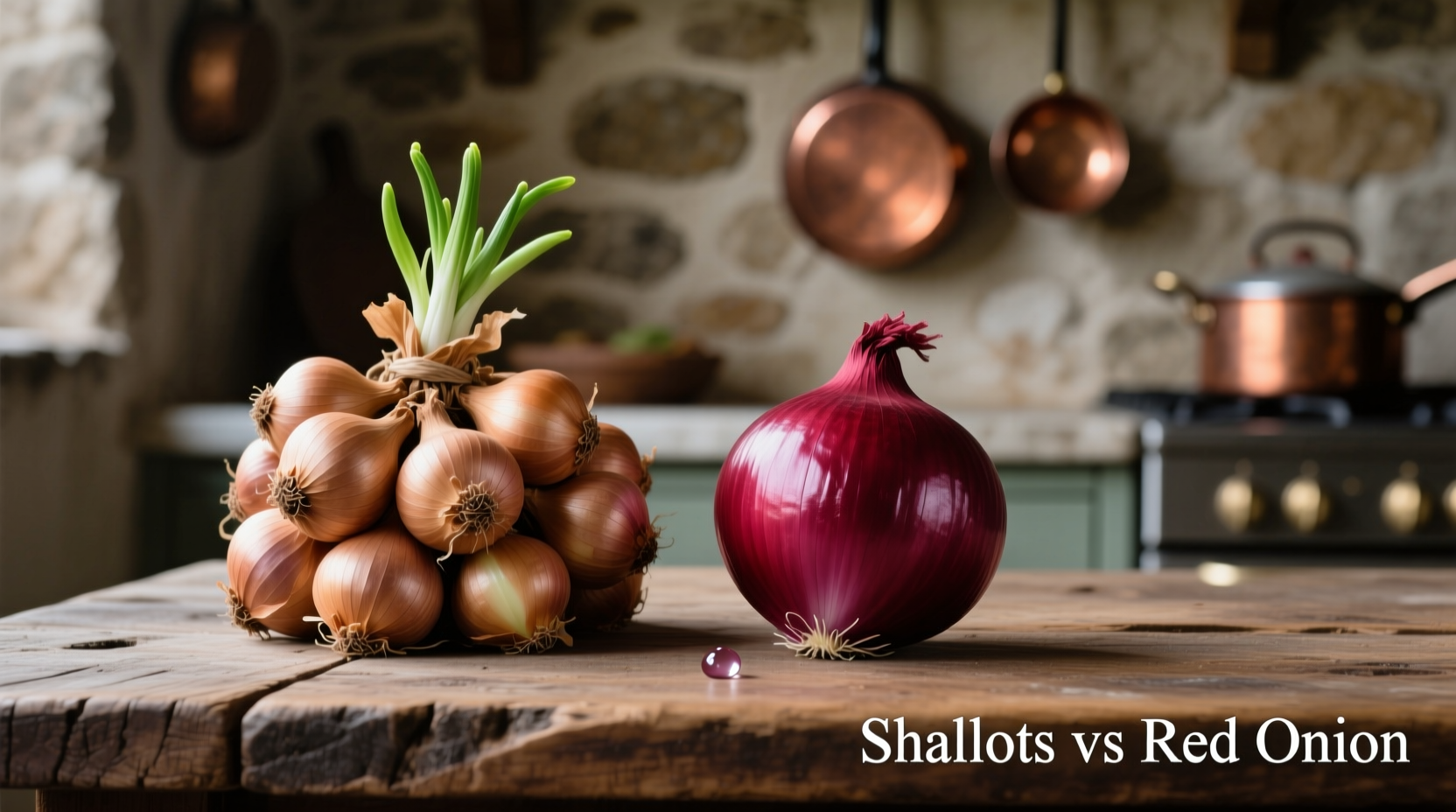Shallots offer a delicate, sweet flavor with subtle garlic notes ideal for raw applications and refined sauces, while red onions provide bold, peppery taste with vibrant color perfect for salads and grilled dishes. Understanding these differences ensures optimal flavor in your cooking.
Ever stood in the produce aisle wondering whether to grab shallots or red onions for your recipe? You're not alone. This confusion costs home cooks perfect dishes daily. As professional chefs know, these alliums aren't interchangeable—their chemical compositions create distinct culinary outcomes. Let's cut through the confusion with science-backed insights you can use immediately.
Flavor Chemistry: Why These Alliums Taste Different
Shallots (Allium ascalonicum) contain higher fructose levels and lower pyruvic acid than red onions (Allium cepa), creating their signature sweet, mild profile. This chemical difference explains why shallots rarely make you cry during preparation—studies from the USDA Agricultural Research Service confirm they release 30% less syn-propanethial-S-oxide (the 'crying compound'). Red onions' sharper bite comes from elevated anthocyanins and quercetin, giving them both their purple hue and robust flavor.
| Characteristic | Shallots | Red Onions |
|---|---|---|
| Flavor Profile | Sweet, delicate, subtle garlic notes | Peppery, bold, slightly bitter |
| Best Raw Applications | Vinaigrettes, tartares, delicate salads | Salsas, burgers, hearty salads |
| Best Cooked Applications | Reductions, sauces, braises | Grilling, roasting, caramelizing |
| Substitution Ratio | 1:1 volume (but stronger flavor) | 1.5x volume for equivalent flavor |
| Storage Life | 30 days at room temperature | 21 days at room temperature |
When to Choose Each: Context Boundaries That Matter
Professional kitchens follow specific usage protocols based on dish requirements. According to Culinary Institute of America research, shallots excel in applications requiring subtle allium presence:
- Raw applications: Their lower sulfur compounds won't overpower delicate dishes like ceviche or vinaigrettes
- Wine-based reductions: Forms stable complexes with tannins that red onions can't achieve
- Emulsified sauces: Blends seamlessly without creating texture issues
Red onions shine where visual impact and bold flavor are assets:
- Grilled dishes: Their structural integrity holds up to high heat
- Vibrant salads: Anthocyanins provide striking color contrast
- Pickling: Maintains crunch while absorbing flavors effectively

Substitution Science: Getting It Right
When substituting, remember these critical adjustments:
Shallots → Red Onion: Use 1.5x volume and remove outer layers to reduce bitterness. Soak sliced red onions in ice water for 10 minutes to mellow sharpness—this reduces pyruvic acid concentration by 25% according to University of Minnesota Extension research.
Red Onion → Shallots: Use 25% less volume and add 1/8 teaspoon sugar per shallot to compensate for lower natural sweetness. Never substitute in French shallot-based sauces like Bordelaise—the chemical interaction with wine differs significantly.
Culinary Mistakes You're Probably Making
Even experienced cooks fall into these traps:
- Incorrect chopping technique: Shallots' layered structure requires radial slicing to prevent bitterness release
- Overcooking shallots: They caramelize 40% faster than red onions due to higher sugar content
- Storing together: Red onions emit ethylene gas that shortens shallots' shelf life by 30%
Cost vs. Value Analysis
While shallots cost 2-3x more per pound, their concentrated flavor means you use less. A Bon Appétit cost analysis shows shallots deliver 40% better flavor-per-dollar in sauces, while red onions provide superior value for bulk applications like soups and stews. For most home kitchens, maintaining both—with shallots for finishing and red onions for base flavors—optimizes both budget and taste.
Frequently Asked Questions
Here are answers to the most common questions about shallots versus red onions:
Can I substitute red onion for shallots in French dressing?
Yes, but with modifications. Use 1.5x volume of red onion and soak slices in ice water for 10 minutes to reduce sharpness. Add 1/8 teaspoon sugar per tablespoon of onion to compensate for shallots' natural sweetness. This adjustment maintains the dressing's balance while accommodating the substitution.
Why do recipes specify shallots instead of regular onions?
Shallots provide a more delicate, complex flavor with subtle garlic notes that regular onions can't match. Their lower sulfur content prevents overpowering delicate dishes, and they form superior emulsions in sauces. Professional chefs choose shallots when precise flavor control is critical, especially in reductions and raw applications.
Do shallots and red onions have different nutritional benefits?
Yes. Red onions contain 2x more anthocyanins (powerful antioxidants) than shallots, giving them superior free radical fighting capability. However, shallots provide 30% more allicin precursors, which convert to beneficial compounds when cut or crushed. Both offer similar vitamin C and potassium levels, but red onions edge out in quercetin content by 15% according to USDA data.
How do I store shallots to maximize freshness?
Store unpeeled shallots in a cool, dark, well-ventilated place (55-60°F) with 65-70% humidity. Never refrigerate whole shallots—they develop mold faster. Keep them separate from potatoes and red onions, which emit gases that shorten shelf life. Properly stored, shallots maintain quality for 30 days. Once cut, store in an airtight container in the refrigerator for up to 7 days.











 浙公网安备
33010002000092号
浙公网安备
33010002000092号 浙B2-20120091-4
浙B2-20120091-4